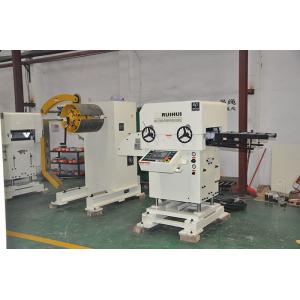
Add to Cart
Mechanical NC feeder feeding speed, high-speed gear replacement feeder high-precision feeding
The principle of the NC feeder is that the servo motor and the PLC control system drive the timing belt to drive the upper and lower rollers to rotate and press loose to achieve quantitative feeding.
Advantages of NC feeder: Double control mode of button and touch screen, easy to operate, servo control, higher feeding accuracy, and multi-stage feeding.
It is convenient to set the feeding length, and the maximum feeding length can reach 9999.99MM, which can realize the wide stamping industry with long feeding step.
Disadvantages of NC feeder: Pneumatic NC maximum speed is 200 beats / min, mechanical NC maximum feed speed is 250 beats / min, and the price is slightly higher.
The high-speed gear-changing feeder is a cam-driven intermittent feeding method. The change of the feed distance is changed from 2 to 4 gears.
Advantages of high-speed gear change feeder: The unique split cam mechanism and precision gear ensure high-precision, high-speed feeding.
There is no need to adjust the feed thickness, and the feed distance can be changed only by gear. The relaxation device is an eccentric cam, so the relaxation angle can be freely adjusted from 0° to 180°.
Disadvantages of high-speed gear replacement feeder: small application range and high price.
The clip feeder is driven by a cam and uses a curved cam and three plate cams to achieve high-speed and smooth feeding. Built-in inspection mechanism to detect blockage or deformation of materials.

The 165 degree feed section angle allows the material to stay longer in the press. Combined with the mold guiding pin, the release time of the material during guiding can be adjusted. It can transport round or square wires.
Advantages of the clip feeder: The feeding speed can be synchronized with the punching machine, and the speed can be as fast as 1200 times/min. The feeding precision is higher, more stable, and the machine is lighter and smaller.
Suitable for feeding processing of ultra-thin materials, such as connectors, lead frames, and inspection parts, such as high-precision and high-speed stamping.
Disadvantages of the clip feeder: generally used for material feeding in 0.1~0.5mm, the scope of application is small, and the price is relatively high.
Specifications:
| Model | MAC4-600F | MAC4-800F | MAC4-1000F | MAC4-1300F |
| Stock Width(mm) | 70~600 | 70~800 | 70~1000 | 70~1300 |
| Stock Thickness(mm) | 0.6~6.0 | 0.6~6.0 | 0.6~6.0 | 0.6~6.0 |
| Max.Coil Weight(kg) | 5000 | 5000 | 7000 | 10000 |
| Max.Coil O.D.(mm) | 1400 | 1400 | 1400 | 1400 |
| Coil I.D.(mm) | 508 | 508 | 508 | 508 |
| Feed Length(mm) | ~500* | ~500* | ~500* | ~500* |
| Max.Line Speed(m/min) | 16~24 | 16~24 | 16~24 | 16~24 |
| Work Roll Number(piece) | upper 6/lower 5 | upper 6/lower 5 | upper 6/lower 5 | upper 6/lower 5 |
| Feed Roll number(set) | 1 | 1 | 1 | 1 |
| Main Motor | AC7.5 | AC11.0 | AC11.0 | AC11.0 |
| Mandrel Expansion | Hydrauilc | Hydrauilc | Hydrauilc | Hydrauilc |
| Reel Motor(kw) | 2.2 | 2.2 | 3.7 | 7.5 |
| Power(v) | 3 Phase 220V/380V/50HZ | |||
| Operating Air(Mpa) | 0.49 | 0.49 | 0.49 | 0.49 |
Straightening Performance:
| Model | MAC4-600F | MAC4-800F | MAC4-1000F | MAC4-1300F | |
| Stock Thickness (mm) | 0.8~2.3 | 600 | 800 | 1000 | 1300 |
| 2.8 | 933 | 933 | |||
| 3.2 | 714 | 714 | 714 | ||
| 4.0 | 457 | 457 | 457 | 457 | |
| 4.5 | 361 | 361 | 361 | 361 | |
| 5.0 | 293 | 293 | 293 | 293 | |
| 6.0 | 203 | 203 | 203 | 203 | |
Products:


![]()